Cultivation of Maize; Zea Mays
Cultivation of Maize; Zea Mays
Maize is an important staple food crop of India that is grown on the plains (as irrigated and upland crop) and on hills or mountains having moderate rainfall.
Climate Requirement for the Cultivation of Maize;
Warm weather favors the growth, development, and yield of maize but it is practically grown in extremely divergent climatic conditions viz. temperate to tropical, up to altitudes of over 2500 meters, however, a night temperature below 15.2°C and frost at any stage of growth may become fatal for the crop stormy weather is extremely harmful as it causes splitting of tender leaves and lodging of plants.
Soil Requirements for Cultivation of Maize;
Land preparation for Maize Cultivation ;
A seedbed of maize should be well-leveled, fine but compact, and free from weeds or stubbles of the previous crop. This could be achieved by one deep ploughing followed by a few harrowings or discing and planking. Provisions for efficient surface drains should be made to avoid flooding during the rainy season. To control soil-infesting insects like termites, white grubs, etc. phorate/carbofuran @ 1.5 kg a.i/ha should be used in the soil at the time of last tilling
Time of Sowing for Maize Cultivation ;
Planting in rows at a distance of 50cm x 30 cm or 60 cm x 25 cm gives about 60 to 75 thousand plants/ha the highest grain yield. However, a closer spacing during the rabi and spring seasons than Kharif planting proves better in boosting productivity
Method Maize of sowing ;
Line sowing has proved its superiority over broadcasting for grain production. Sowing may be done by using a seed drill, maize planter or by dropping the seed behind the plough however, broad-casting is preferred for fodder crops of maize.
Seed rate ;
The grain crop of maize requires about 15-20 kg of seed/ha while for the fodder crop of maize, 35 to 40 kg seed/ha is enough.
Fertilizer management in Maize Cultivation ;
Apply 12 to 15 tonnes of FYM at the time of land preparation.
The nutrient application should be based on soil test performance. Apply 120:60:0:25 kg/ha N, P, K, and ZnSO4.
A full dose of phosphorus, potash, and zinc, and 30% N should be applied as a basal dose.
The remaining dose of nitrogen should be applied in two splits at knee high and tasselling to avoid losses and to meet the requirement throughout the crop cycle.
Apply the recommended dose of Neem oil coated urea (NOCU) in 700 ppm concentration will result in a higher yield and better use of nitrogen efficiency in the Kharif maize.
Irrigation Requirement for Maize Cultivation ;
A rainfed crop of Kharif maize could be successfully grown in areas having 60 cm well-distributed rainfall but a moisture stress condition during flowering and grain filling stages causes a drastic reduction in grain yield. Rabi and spring season crops are grown exclusively under irrigated conditions and the number of irrigations ranges between 5 to 10 based on the duration of the variety, soil type, prevailing atmospheric temperature, etc. Most critical stages for irrigation are the seedling stage, knee height stage, flowering stage and grain filling stage, etc Light and frequent irrigations are preferably better.
Weed management ;
The maize crop is found to be badly infested with numerous types of weeds in the initial stage which suppresses the crop growth badly, therefore, two weedings at 20 days intervals after sowing maintain a weed-free situation. Two to three hoeings are done by kudali for pulverizing the surface and providing aeration to crop roots. Sometimes bullock-drawn cultivator is used for inter-row cultivation but the weeding within the rows has to be done manually, by using khurpi, however inter-cultivation after the plants have attained knee height or when they have started flowering should not be done as it may damage the leaves and lateral roots. Often constant rains keep the soil wet and manual operation becomes impossible, therefore, spraying of Simazine or Atrazine @ 1 to 1.2 kg/ha (50% w.p.) in 500-600 liter of water before crop emergence brings about effective control of weeds. The fodder, however, does not need any weeding because of its dense plant population.
Note ;
- While spraying, the person doing spray should move backward so that the Atrazine film on the soil surface may not be disturbed.
- Three nozzle booms may be ideally used for the proper ground coverage and it is also a time-saving tool.
- One to two hoeing is recommended for the aeration and uprooting of the remaining weeds.
- While doing hoeing, the person should move backward to avoid compaction of soil and to facilitate better aeration.
Intercropping in Maize Field ;
- There is no adverse effect of intercrops on maize and vice-versa, rather, some of the intercrops help in improving soil fertility
- Intercropping protects the maize crop from cold injury.
- Intercrops protect the maize from the northern cold wind because maize is planted on the southern side and intercrops on the northern side of the ridge.
- Mostly, short-duration varieties of intercrops are preferred for intercropping with maize.
- The doses of fertilizers for the intercrops must be applied as per the recommendations in addition to the doses applied of fertilizers for maize cultivation.
- In the Kharif season, cowpea for green pods and fodder purposes, urd-bean, mungbean, etc. can be intercropped with maize.
- A number of intercrops are an option for the farmers but for commercial purposes, peas and potatoes can be taken on a large scale during the winter season
- Short Duration crops like; Potato, green pea, rajma for green pods, palak, cabbage, cauliflower, sugar beet, green onion, garlic, methi, coriander, knol-khol, broccoli, lettuce, turnip, radish, carrot, french bean, celery, gladiolus, etc. have been successfully tried in the winter season.
Insect- Pest Management in Maize Crop ;
Control of Stem borer and Pink Borer: For control of stem and pink borer, a foliar spray of 0.1 % Endosulfan {700 ml (35 EC) in 250-liter water} 10 days after germination is very effective. The stem borer can also be controlled by the release of 8 Trichocards (Trichogramma chilonis) per hectare at 10 days after the germination. Intercropping of maize with suitable varieties of cowpea is an eco-friendly option for reducing the incidence of stem borer on maize.
Shoot fly (Atherigona sp.) ;
Shoot fly is a serious pest of the southern regions but Shoot fly also appears on spring and summer maize crops in the Northern regions of India. Shoot fly primarily attack at the seedling stage of the maize crop. The tiny maggots of the shoot fly creep down under the leaf sheaths until they reach the base of the seedlings. Afterward, they cut down the growing point or central shoot which ultimately results in the formation of a dead heart.
Control of Shootfly:
• Spring Sowing of the maize crop must be completed before the first week of February so that the crop will escape from the shoot fly infestation.
• Spring sowing of maize crops must be completed with seed treatment with Imidacloprid @ 6ml/kg seed.
Termites (Odontotermes obesus) ;
Termite is also an important pest problem of maize crops in many areas. For control of termites, apply fipronil granules @ 20 kg ha-1 accomplished by light irrigation. If the termite incidence occurs in patches then spot application of fipronil @ 2-3 granules/plant should be done. Clean cultivation of the maize crops delays termite attacks.
Other emerging pests:
Recently some other non-traditional pests of maize crop are also causing damage to maize crop like the larvae of American Bollworm (Helicoverpa armigera) which causes damage to cob in the southern states of India while the Chaffer beetle (Chiloloba acuta) feeds on maize pollen which adversely affects pollination in the northern states of India.
Disease management in Maize Cultivation ;
BLSB, Pythium stalk rot, Bacterial stalk rot, PFSRs, Polysora rust, and Downy mildew are some of the major diseases of the maize crop which occur across the country in different seasons because of these diseases maize crop suffers major yield losses. It is estimated that due to diseases there is a substantial loss occurs in maize crop yields which are approx. 13% ( out of which 5% yield loss is due to the root rots, stem rots, and ear rots and 5% yield loss is due to foliar diseases ) The major diseases and their management practices are described below:
Turcicum leaf blight (Exserohilum turcicum) ;
This disease most commonly occurs in low-temperature condition with a high relative humidity area. Long, elliptical, greyish-green, or tan lesions (2.5-15 cm) appear on lower leaves progressing upward. Grow the resistant varieties in these areas followed by need-based sprays of mancozeb @ 2.5 g/litre (with adjutant @ 0.05%) at 8-10 days of intervals.
Maydis leaf blight (Drechslera maydis) ;
It is a major disease under the warm humid temperate to tropical climate during the cropping period. The major symptom of this disease; Lesions on the leaves elongated between the veins, tan with buff to brown or dark reddish-brown borders. Lesion size may vary in Maize inbreds and maize hybrids due to different genetic backgrounds. Growing of resistant varieties with the need-based application of mancozeb or zineb @ 2.5g/liter of water.
Common rust (Puccinia sorghi) ;
This rust attacks in the maize growing areas with subtropical temperate and high land environments It appears at the time of tasselling. The circular to elongate, golden brown to cinnamon brown pustules are visible over both leaf surfaces changing to brownish-black at plant maturity. Adopt promising hybrids/ varieties. A spray of mancozeb@ 2.5g/liter of water at the first appearance of pustules. Prefer early maturing varieties.
Polysora Rust (Puccinia polysora) ;
This disease is commonly found in areas where mild temperature and high relative humidity persist. Light cinnamon golden brown circular to oval pustules can be seen on the leaf which is densely spread on the upper surface of the leaf. There is a development of more number of pustules on the lower surface in comparison to the upper surface of the leaf. Sowing of the maize composites and the hybrids seeds which are resistant to Polysora rust disease is recommendable.
Banded leaf and sheath blight(Rhizoctonia solani f. sp. Sasakii)
it is a common disease that mainly occurs in the foothills region of the northern states of the country. The visible symptom of the disease is the white lesions on the leaves and sheath of the maize plant. The Purplish or brown horizontal bands are present on white lesions. This disease appears on leaves and sheaths on 40-50 days old plants and later on spread to the ears. The characteristic lesions appear as concentric bands and rings on lower leaves and sheaths (first and second). The affected plant of maize produces large, grey, tan, or brown discolored areas alternating with dark brown bands. Later on, the Sclerotia are formed in these areas. The developing ear of maize plants is completely damaged and dried up prematurely with a cracking of the husk leaves. Brown rotting of the maize plants’ ears may develop which shows the conspicuous light brown cottony mold with small, round black sclerotia. The Stripping of lower 2-3 leaves along with their sheath considerably lowers incidence. grow the tolerance varieties to this disease. The seeds must be treated with a peat-based formulation @ 16 g/kg of Pseudomonas fluorescence or as soil application @ 7g/litre of water, carbendazim, thiophanate-methyl and 12 captan and a foliar spray (30-40 days old maize crop) of tolcofos-methyl @ 1g/ litre or validamycin @ 2.7ml/litre of water. 
Areas under the high temperatures with high relative humidity are more prone towards the incidence chances of the maize disease of Pythium and bacterial stalk rot. In Pythium stalk rot, the diseased area of the stalk is brown, water-soaked, soft and collapsed usually confined to a single internode just above the soil surface. The maize crop plants get twisted due to rotting at infected portion resulting in lodging. The bacterial stalk rot pathogen can infect the plant at any node from the soil surface up to the whole plant. Primary symptoms of discolouration due to tan to dark brown, water-soaked slimy lesions on the leaf sheath and stalk generally appear when plant suddenly falls over and are seen scattered in the field. Splitting of stalk exposes internal discolouration and soft slimy rot at the nodes. A foul odor can be sensed from macerated tissues and the top of such plants can be very easily removed from the rest of the plant. Good field drainage (to avoid waterlogging), planting time between 10 and 20th July in North India, plant population of not more than 50,000/ha reduce the less disease. Application of 75% captan @ 12 g/100 litres of water and bleaching powder (33% chlorine) @ 10 kg/ha as soil drench help in the control of these stalks.
Post Flowering Stalk Rot of Maize (PFSR) ;
The PFSR occurs mainly in Rajasthan, Uttar Pradesh, Bihar and Andhra Pradesh. The disease appears when the crop enters in senescence phase. Most commonly pathogen affects the roots crown regions and lower internodes. When split open, the stalk shows pink-purple discolouration. For effective control of the PFSR disease, water stress at the time of flowering should be avoided. Always use a balanced dose of nutrients wherein potassium application helps in minimizing the disease. Use of biocontrol agents (Trichoderma formulation) in furrows mixed with FYM @ 10g/kg at 10 days prior to its use in the field. It is always advisable to practise crop rotation to minimize disease incidence.
Downy mildews (DM) ;
DMs group of pathogens are one of the most important factors limiting maize production in the country. Some of the most important species causing downy mildew of maize in India are the Sorghum downy mildew (SDM; Peronosclerospora sorghi), Brown stripe downy mildew (BSDM; Sclerophthora rayssiae var. zeae) and Rajasthan downy mildew (RDM; Peronosclerospora 13 hetropogoni). BSDM is found in Himachal Pradesh, Sikkim, West Bengal, Meghalaya, Punjab, Haryana, Rajasthan, Uttarakhand, Bihar, Madhya Pradesh and Gujrat; SDM in Gujrat, Maharashtra, Andhra Pradesh, Karnataka, Tamil Nadu and RDM in Rajasthan and surrounding areas. In BSDM, Maize crop leaves possess a narrow, chlorotic or yellowish stripe with well-defined margins, and delimited by the veins appear. Downy or woolly cottony whitish growth can be easily visible in the early morning hours on lower surfaces of the lesions. Chlorotic plants are seen in SDM infected fields and the affected area includes the base of the blade with a transverse margin and is easily defined between diseased and healthy tissue. RDM symptoms are characterized by the pale appearance of bases of second & third diseased leaves of the seedling giving complete chlorosis or chlorotic strips. Severely infected plants of the corn crop give a yellowish appearance even from a faraway distance. The infected plants die at the about knee-high stage. Maize crop plant shows local or secondary symptoms which start appearing from 2-3 leaf stage until tassels and silks are formed. The plants under the prevailing humid conditions show a whitish fluffy growth due to abundant fructification of the fungus can be observed on the lower and upper leaf surfaces of the maize crop plants. Tassels may be malformed producing less pollen while ears may be aborted resulting in partial or complete sterility. In early symptoms, plants are stunted and may die. Rogue and destroy infected plants as they appear in the field. Maize-sorghum crop rotation in the field where the disease has occurred should be avoided. Avoid sowing of maize crop adjacent to a field of maize or sorghum to avoid the spread of secondary infection. Early planting of maize escapes RDM infection. Use resistant varieties /hybrids Seeds should invariably be treated with metalaxyl @ 2.5g/kg seed and need-based foliar sprays of a systemic fungicide such as metalaxyl @ 2-2.5g/L is recommended at the first appearance of disease symptoms.



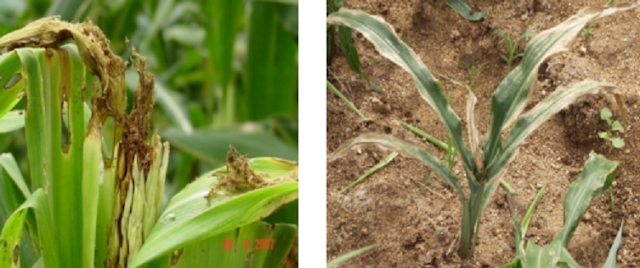
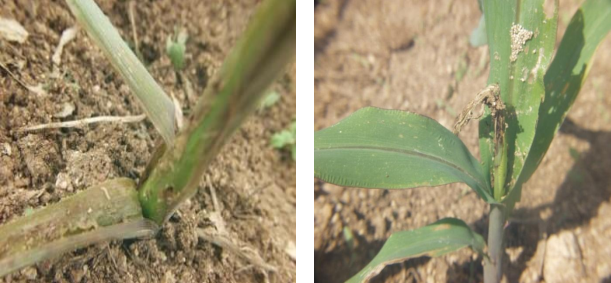
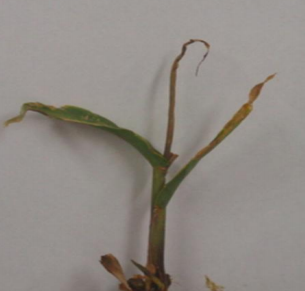
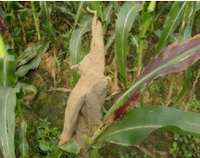

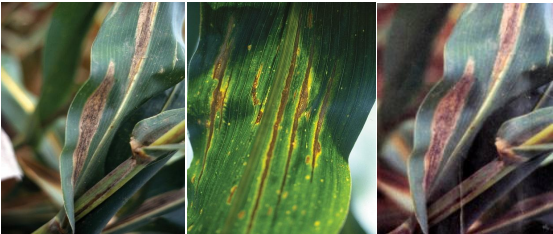
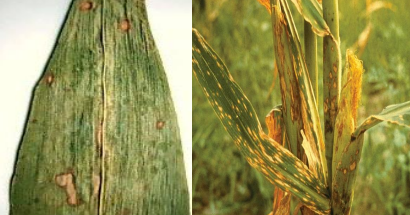
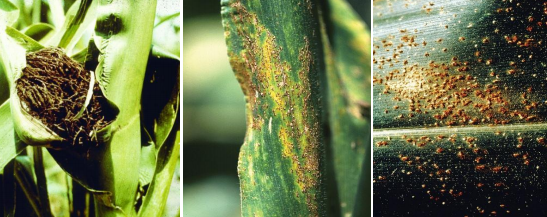
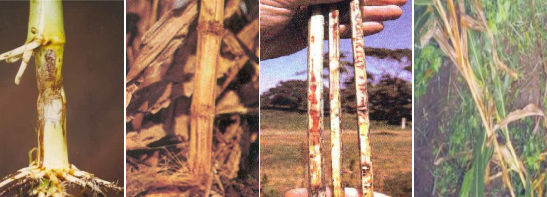
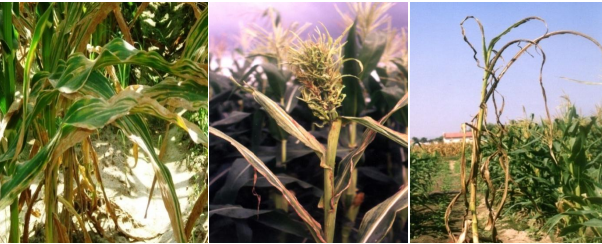
Pingback: Sorghum ((Sorghum bicolor L) or Jwoar Cultivation in India - Agrovista-Farming